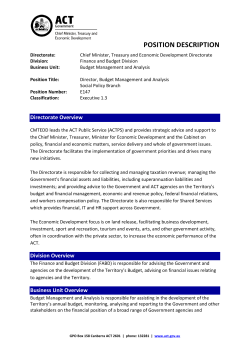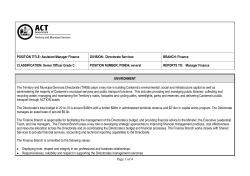
Transitioning to an Enterprise Ground System
Advanced Systems & Development Transitioning to an Enterprise Ground System Lt Col Matt Kimsal SMC/ADY Envisioning and Shaping the Future of Space BLUF ADVANCED SYSTEMS AND DEVELOPMENT DIRECTORATE • SMC/AD is generating a plan for the transformation of AFSPC Ground Systems • Technical and program discussions ongoing with key stakeholders • Transition Plan to AFSPC/CC planned for the end of April Envisioning and Shaping the Future of Space 2 Motivation For SATOPs Evolution ADVANCED SYSTEMS AND DEVELOPMENT DIRECTORATE • AFSPC Directives / Guidance • • • • 2008 AFSPC/CC 2011 AFSPC/CC 2013 AFSPC/CC requested ISAG on future Ground Enterprise options Drivers for the transformation • • • • • • Increasing budget constraints Increasing sustainment cost Evolving mission requirements Tech maturity & emerging threats GAO criticism Success by other Gov’t offices • • • SATOPs Enterprise Transformation (SET) • • • Eliminate stovepipes Consolidate common functions Utilize data standards NRL NRO SMC (MMSOC) Envisioning and Shaping the Future of Space 3 Building the Future of Military Space Characteristics of an Enterprise Ground Cloud Computing Solution ADVANCED SYSTEMS AND DEVELOPMENT DIRECTORATE Enterprise Satellite Ground Operations Virtualized Ops Resilient-Rapid Access to Space Rapid Demos Residual Ops Survivable Fusion of Enterprise Data Legacy Ops Endurable Lights Out Automation Cyber Security Agile Commercial JIE Ops Compliant Open Architecture Affordable, Resilient, Shared, Multi-User Common Ground Reduced O&M Burden Focus Airmen on Mission data vice TT&C Integration with JSpOC, JMS, Data Centers, Commercial Providers and International Partners Leveraging MMSOC Mindset as the Test Bed for a Future AFSPC Ground Enterprise Envisioning and Shaping the Future of Space 4 Scope ADVANCED SYSTEMS AND DEVELOPMENT DIRECTORATE Commander’s Intent AF Outcomes Reduce cost and repurpose manpower for “fighting with space” Consolidate common functions and automate repetitive satellite C2 tasks Establish government control and ownership of the technical baseline; Make space derived products, data and information services more accessible to innovators, commanders, analysts and operators at the tactical edge Improve Warfighter Effects Make tasking and response more dynamic Enable control of forces and resilience options to “fight through” Exploit synergies to fight with space Optimize resources across space mission operations Provide visibility across flexible, adaptable, and defensible satellite control operations Envisioning and Shaping the Future of Space Command Strategy Consolidate TT&C Near Term Focus Expose Data Integrate Mission Management Modernize TX/RX Networks Boundary Conditions ADVANCED SYSTEMS AND DEVELOPMENT DIRECTORATE • Planning process will be guided by acknowledgment that no new large scale initiative is likely within current budget constraints • End state architecture must be: • • • • Scalable and expandable Cyber secure and resilient Compliant with future JIE objectives Transition plan must identify and minimize risks to mission area ground deployments and operations • To be developed in collaboration with SPOs Envisioning and Shaping the Future of Space 6 Schedule ADVANCED SYSTEMS AND DEVELOPMENT DIRECTORATE FY2015 Plan FY2017 FY2018 FY2019 Phase I Establish Infrastructure Transition FY2016 Phase II + Early Capability Demos Phase III Expanded Phase I Tasks and Schedule Envisioning and Shaping the Future of Space 7 Functional Organization ADVANCED SYSTEMS AND DEVELOPMENT DIRECTORATE Project Management Technical Baseline Life Cycle Process Management Transmit/Receive Networks Platform & Operational Concepts • • • SMC/AD Aerospace MITRE Lt Col Matt Kimsal (ADY) Lt Col Brian Bracy (ADG) Kevin Wilson Asya Campbell Mark Fahl John Derby IA Process Mapping & Cyber Resilience Supporting data and analysis which informs transition decisions Integrated Planning Map Acquisition Planning Processes to execute the transition and manage the Life Cycle of EGS Funding Strategies & Cost Estimation Strategies on what to transition to and how to fund and execute the next phases of the project Focused tasking with cross-organization teams • AF + Aerospace + MITRE Short project timeline requires parallel activities Build on previous foundational studies Envisioning and Shaping the Future of Space 8 Architectural Transition ADVANCED SYSTEMS AND DEVELOPMENT DIRECTORATE • Current State • • • • No commonality in applications and services across missions Contractors “own” the stack which defines the architecture Each mission area has its own hardware set Duplication, without commonality, of ground capability and costs EGS Transition Leads to • Common infrastructure • • • • • Leverages low-cost commercial data center practices OTB returns tight integration control to the government Common Infrastructure Common services and applications for C2 Common security practices Enterprise Ground Services • • • Creates common practices environment for mission unique applications Promotes best practices for software development Enables easier transition through single Interface Envisioning and Shaping the Future of Space 9 Transition Strategy ADVANCED SYSTEMS AND DEVELOPMENT DIRECTORATE Legacy Systems MUS FIRST STEP: Stand up Systems Integration Lab MUS Misc SATOPS Fns Misc SATOPS Fns TT&C HW TT&C HW MUS Misc SATOPS Fns TT&C HW MUS MUS Misc SATOPS Fns MUS Misc SATOPS Fns TT&C Misc SATOPS Fns … Realized Savings TT&C HW MUS MUS MUS Future MUS Development / Test / Demonstrations Common H/W and initial limited services (TT&C, Flt Dynamics) Common Infrastructure (H/W) … Middleware and Interfaces Common H/W and Enterprise Services Suite (TT&C, Flt Dynamics, Scheduling, Security, Data Distribution, etc) Middleware and Interfaces Benefits 1) Systems run on common H/W 2) Decreased H/W Baseline 3) Proof of Concept Benefits 1) Systems run on common H/W and M/W 2) Shared resources optimized b/w systems 3) Maintenance and sustainment efficiencies 4) Government increases ownership and control of technical baseline Benefits 1) Systems run on common services 2) Minimizes mission unique S/W 3) Highest efficiencies maintenance and ops 4) Savings on future development 5) Government fully owns and controls technical baseline Envisioning and Shaping the Future of Space Operational Demonstrations ADVANCED SYSTEMS AND DEVELOPMENT DIRECTORATE • An important component of the Transition is building confidence through relevant demonstrations • • • Automation Multiple TT&C engines on a Service Based Architecture Initially on MMSOC at RSC (Kirtland AFB) • Demonstrations in the mid-term: experimental and residual satellites • • • • • SENSE DSP DSCS Milstar GPS Envisioning and Shaping the Future of Space 11 Phase I Objectives ADVANCED SYSTEMS AND DEVELOPMENT DIRECTORATE • A detailed end state architectural vision for achieving mission objective • A transition plan to move the current AFSPC ground systems to the defined end state vision • Identification of near term pathfinder activities/projects/demonstrations which assist transition to the end state • Creation of sufficiently detailed plans for submission through formal AFSPC CFSP planning processes, and associated inputs to POM Planning • Development of a planning roadmap aligned to the JCIDS process, as applicable Envisioning and Shaping the Future of Space 12 Way Forward ADVANCED SYSTEMS AND DEVELOPMENT DIRECTORATE • • • • • Transition Plan to be developed in collaboration with SMC SPOs Stakeholder communication is an ongoing process Continue demonstration planning Final Briefing to AFSPC/CC early May 2015 Initiate Transition Plan immediately upon approval Envisioning and Shaping the Future of Space 13 How Can Industry Help? ADVANCED SYSTEMS AND DEVELOPMENT DIRECTORATE • Start preparing to support the target architecture • • Supporting and maintaining a cloud environment Developing and instituting a set of standard interfaces • Allow us time to define our needs • • • Need a clearer path forward before involving industry Will reach out after conclusion of 90-day study Look for RFIs in the near-mid term Envisioning and Shaping the Future of Space 14
© Copyright 2025









